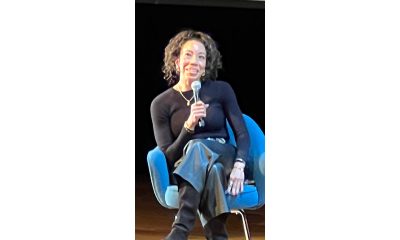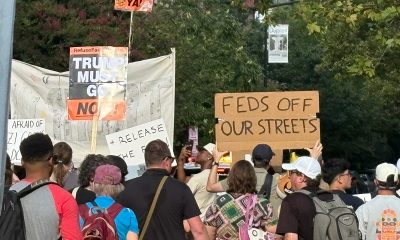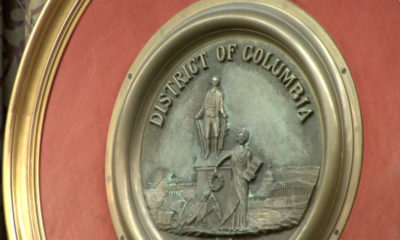Local
Gay GOP donor helped fund ‘Hide/Seek’ exhibit
N.Y. businessman wants controversial crucifix video restored to Portrait Gallery

Editor’s note: a Blade review of the exhibit is here.
A gay Republican businessman from New York who led the fundraising campaign to underwrite the National Portrait Gallery’s gay exhibit “Hide/Seek” has added his voice to those calling on the gallery to reinstate a controversial video by the late gay artist David Wojnarowicz.
Donald Capoccia, a real estate developer who was appointed by President George W. Bush in 2001 to serve on the U.S. Commission on Fine Arts, and his partner, Tommie Pegues, sent a letter this week to the head of the Smithsonian Institution requesting that the video be “returned to the exhibition floor, without fail, and as soon as possible.”
The role of Capoccia and other gay donors who helped fund the exhibit has been overshadowed by a series of events beginning Dec. 1, when National Portrait Gallery director Martin Sullivan removed the Wojnarowicz video from the exhibit.
Sullivan said he acted in response to complaints by the Catholic League and Republican members of Congress that an 11-second segment of the video, which showed ants crawling over a crucifix, was offensive and an anti-Christian slur.
“I regret that some reports about the exhibit have created an impression that the video is intentionally sacrilegious,” Sullivan said in a statement. “In fact, the artist’s intention was to depict the suffering of an AIDS victim. It was not the intention of the museum to offend. We have removed the video.”
News of Sullivan’s decision, which surfaced on World AIDS Day, prompted an outcry among gay and AIDS activists and leaders of the arts community, who denounced the action as a form of censorship.
Sullivan told the New York Times he was sympathetic to the activists and artists who decried the decision to pull the video. He said his decision, which he said had the support of the leaders of the Smithsonian Institution, was aimed at quelling a “distraction” from the overall exhibit, which features important works from leading gay and lesbian artists.
The National Portrait Gallery is an arm of the Smithsonian Institution, which, among other things, operates the federally funded museums in the nation’s capital.
Among those who criticized the video and the exhibit itself were Rep. John Boehner (R-Ohio), who will become Speaker of the House in January, and Rep. Eric Cantor (R-Va.), who will become majority leader at the same time, when Republicans assume control of the House.
Rep. James Moran (D-Va.), whose district includes the Northern Virginia suburbs just outside D.C., said Boehner and Cantor along with other Republicans were exploiting an exhibit, in which just 11 seconds of a single video was offensive to some, for political gain.
Cantor said his concern was that the Smithsonian Institution, of which the National Portrait Gallery is a part, was using government funds to pay for an exhibit that was highly offensive to many Americans.
Cantor and other critics of the exhibit dismissed assertions by Smithsonian officials that private donors picked up the cost of the exhibit, saying taxpayer funds are used for the upkeep of the building and to pay the salaries of Portrait Gallery employees who operate the exhibit.
The National Portrait Gallery has called the exhibit, “Hide/Seek: Difference and Desire in American Portraiture,” the nation’s first major museum exhibition to “focus on sexual difference in the making of modern American portraiture.”
LGBT activists involved in the arts have said the exhibit also shows how gay artists, through their varied works, have grappled with anti-gay bias and prejudice against different forms of gender expression over the past century.
Phillip Clark, chair of the board of D.C.’s Rainbow History Project, called David Wojnarowicz, a gay man who died of AIDS in 1992, an important figure in the LGBT arts community. Clark noted that Wojnarowicz used ants in his video and still photography works as a symbol for depicting human suffering and injustice.
“The image of the Christ figure attacked by ants in ‘A Fire in My Belly’ [the name of the Wojnarowicz video pulled from the exhibit], far from being sacrilegious, is actually a commentary on the destructiveness of society toward AIDS patients in the 1980s,” Clark said.
D.C. gay rights advocate Charles Francis, who recruited former President Gerald Ford to become a board member of a national gay GOP group, the Republican Unity Coalition, before Francis left the Republican Party in 2004, called on the LGBT community to remain supportive of the Smithsonian.
Francis, who joined Capoccia in contributing money to the Hide/Seek exhibit, said he disagrees with the decision by the Portrait Gallery to remove the Wojnarowicz video. But he said the gallery and the Smithsonian as a whole have been supportive of LGBT-related projects in recent years.
“The Smithsonian is doing a great job step by step in expanding and including LGBT Americans in the stories they tell, in the collections they show,” he said. “I think it’s time for the gay community to rally around the Smithsonian.”
PHOTO: “Self-Portrait — Robert Mapplethorpe,” a 1975 Polaroid print, one of the images in the Hide/Seek exhibit at the National Portrait Gallery. Image courtesy of the Estate of Robert Mapplethorpe, New York City.
District of Columbia
Rush reopens after renewing suspended liquor license
Principal owner says he’s working to resolve payroll issue for unpaid staff
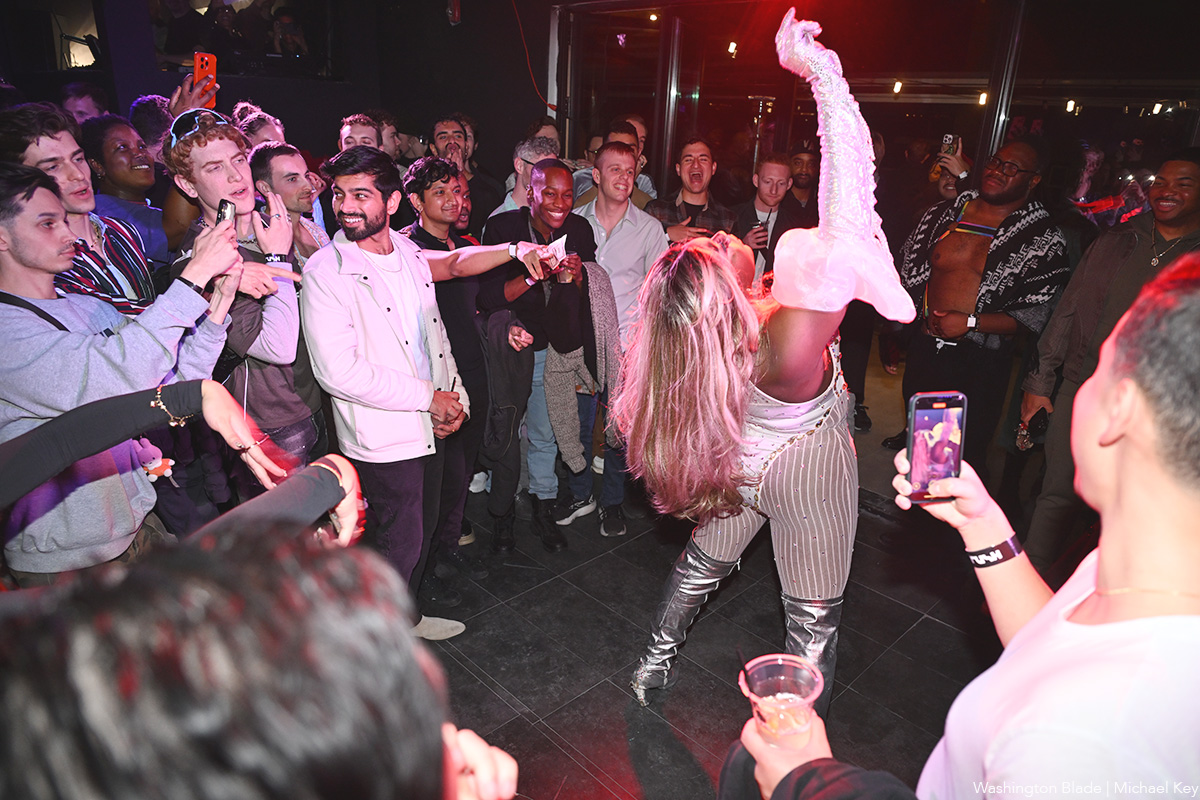
The D.C. LGBTQ bar and nightclub Rush reopened and was serving drinks to customers on Saturday night, Dec. 20, under a renewed liquor license three days after the city’s Alcoholic Beverage and Cannabis Board suspended the license on grounds that Rush failed to pay a required annual licensing fee.
In its Dec. 17 order suspending the Rush liquor license the ABC Board stated the “payment check was returned unpaid and alternative payment was not submitted.”
Jackson Mosley, Rush’s principal owner, says in a statement posted on the Rush website that the check did not “bounce,” as rumors circulating in the community have claimed. He said a decision was made to put a “hold” on the check so that Rush could change its initial decision to submit a payment for the license for three years and instead to pay a lower price for a one-year payment.
“Various fees and fines were added to the amount, making it necessary to replace the stop-payment check in person – a deadline that was Wednesday despite my attempts to delay it due to these circumstances,” Mosley states in his message.
He told the Washington Blade in an interview inside Rush on Saturday night, Dec. 20, that the Alcoholic Beverage and Cannabis Administration (ABCA) quickly processed Rush’s liquor license renewal following his visit to submit a new check.
He also reiterated in the interview some of the details he explained in his Rush website statement regarding a payroll problem that resulted in his employees not being paid for their first month’s work at Rush, which was scheduled to take place Dec. 15 through a direct deposit into the employees’ bank accounts.
Several employees set up a GoFundMe appeal in which they stated they “showed up, worked hard, and were left unpaid after contributing their time, labor, and professional skills to Rush, D.C.’s newest LGBTQ bar.”
In his website statement Mosley says employees were not paid because of a “tax related mismatch between federal and District records,” which, among other things, involves the IRS. He said the IRS was using his former company legal name Green Zebra LLC while D.C. officials are using his current company legal name Rainbow Zebra LLC.
“This discrepancy triggered a compliance hold within our payroll system,” he says in his statement. “The moment I became aware of the issue, I immediately engaged our payroll provider and began working to resolve it,” he wrote.
He added that while he is the founder and CEO of Rush’s parent and management company called Momentux, company investors play a role in making various decisions, and that the investors rather than he control a “syndicated treasury account” that funds and operates the payroll system.
He told the Blade that he and others involved with the company were working hard to resolve the payroll problem as soon as possible.
“Every employee – past or present – will receive the pay they are owed in accordance with D.C. and federal law,” he says in his statement. “That remains my priority.”
In a follow-up text message to the Blade on Sunday night, Dec. 21, Mosley said, “All performers, DJs, etc. have been fully paid.”
He said Rush had 21 employees but “2 were let go for gross misconduct, 2 were let go for misconduct, 1 for moral turpitude, 2 for performance concerns.” He added that all of the remaining 14 employees have returned to work at the time of the reopening on Dec. 20.
Rush held its grand opening on Dec. 5 on the second and third floors of a building at 2001 14th Street, N.W., with its entrance around the corner on U Street next to the existing LGBTQ dance club Bunker.
With at least a half dozen or more LGBTQ bars located within walking distance of Rush in the U Street entertainment corridor, Mosley told the Blade he believes some of the competing LGBTQ bars, which he says believe Rush will take away their customers, may be responsible along with former employees of “rumors” disparaging him and Rush.
Rehoboth Beach
Rehoboth’s Blue Moon is for sale but owners aim to keep it in gay-friendly hands
$4.5 million listing includes real estate; business sold separately
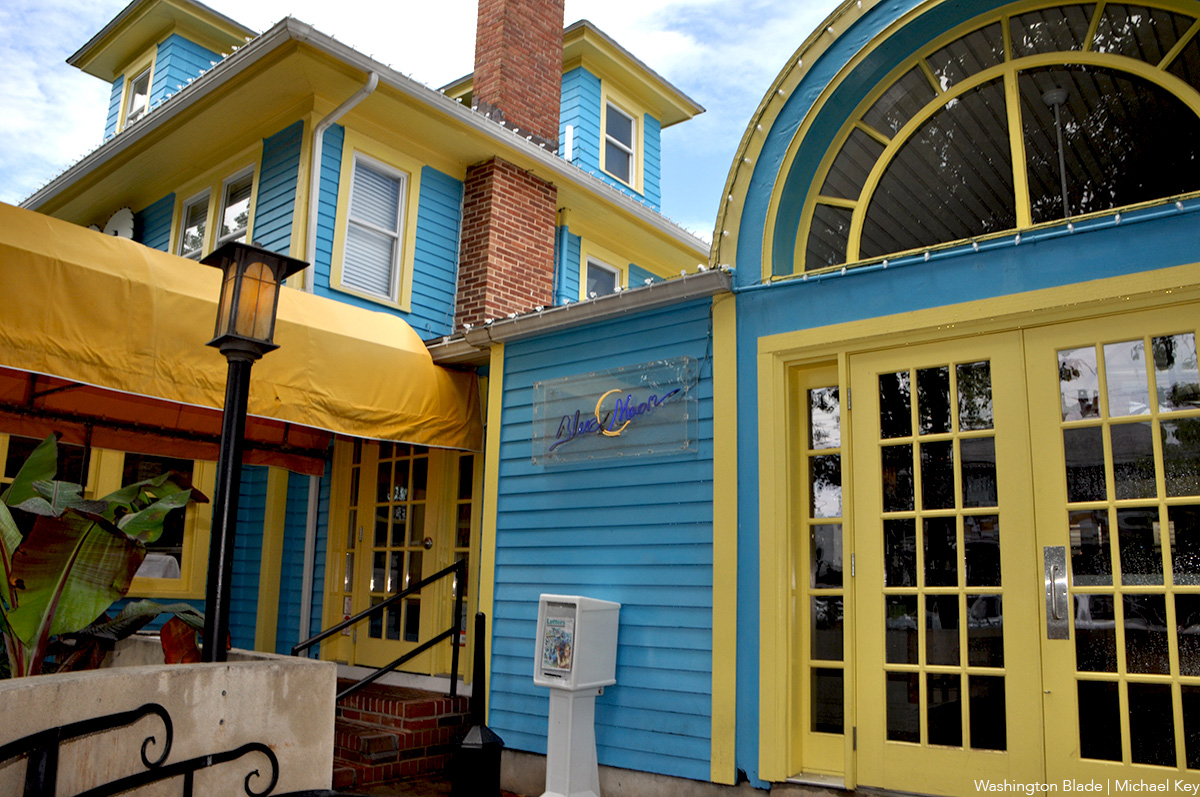
Gay gasps could be heard around the DMV earlier this week when a real estate listing for Rehoboth Beach’s iconic Blue Moon bar and restaurant hit social media.
Take a breath. The Moon is for sale but the longtime owners are not in a hurry and are committed to preserving its legacy as a gay-friendly space.
“We had no idea the interest this would create,” Tim Ragan, one of the owners, told the Blade this week. “I guess I was a little naive about that.”
Ragan explained that he and longtime partner Randy Haney are separating the real estate from the business. The two buildings associated with the sale are listed by Carrie Lingo at 35 Baltimore Ave., and include an apartment, the front restaurant (6,600 square feet with three floors and a basement), and a secondary building (roughly 1,800 square feet on two floors). They are listed for $4.5 million.
The bar and restaurant business is being sold separately; the price has not been publicly disclosed.
But Ragan, who has owned the Moon for 20 years, told the Blade nothing is imminent and that the Moon remains open through the holidays and is scheduled to reopen for the 2026 season on Feb. 10. He has already scheduled some 2026 entertainment.
“It’s time to look for the next people who can continue the history of the Moon and cultivate the next chapter,” Ragan said, noting that he turns 70 next year. “We’re not panicked; we separated the building from the business. Some buyers can’t afford both.”
He said there have been many inquiries and they’ve considered some offers but nothing is firm yet.
Given the Moon’s pioneering role in queering Rehoboth Beach since its debut 44 years ago in 1981, many LGBTQ visitors and residents are concerned about losing such an iconic queer space to redevelopment or chain ownership.
“That’s the No. 1 consideration,” Ragan said, “preserving a commitment to the gay community and honoring its history. The legacy needs to continue.” He added that they are not inclined to sell to one of the local restaurant chains.
You can view the real estate listing here.
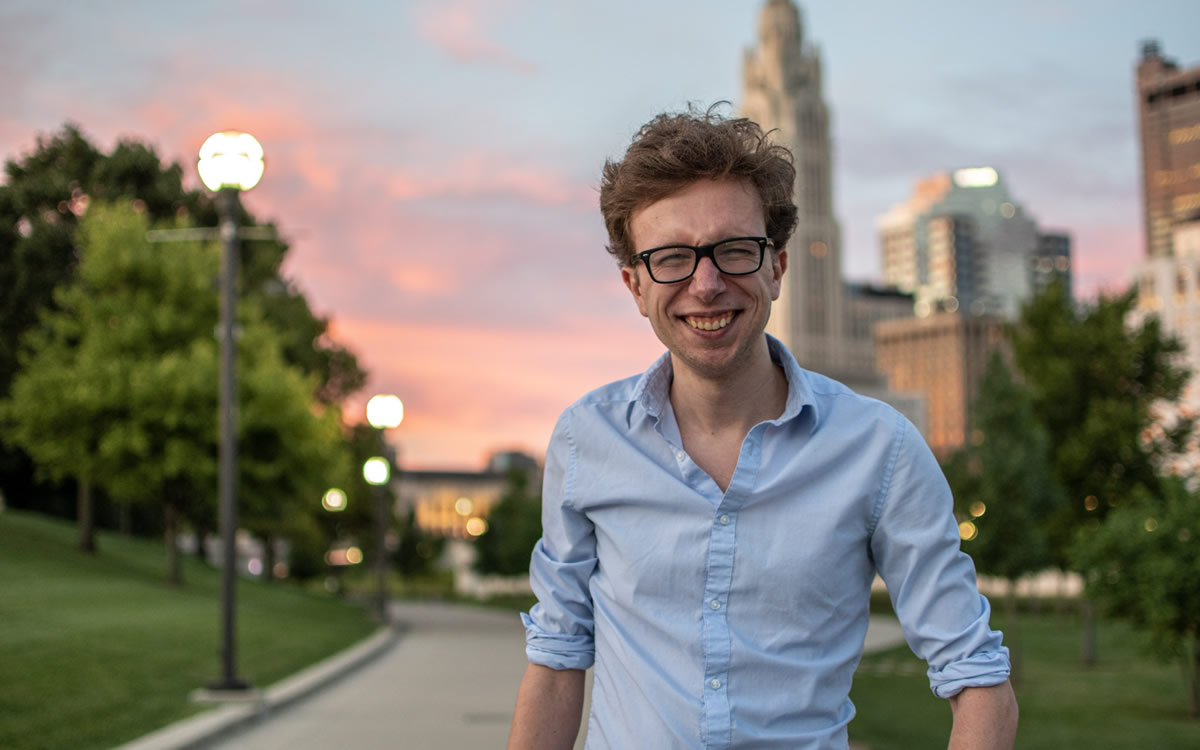
The Comings & Goings column is about sharing the professional successes of our community. We want to recognize those landing new jobs, new clients for their business, joining boards of organizations and other achievements. Please share your successes with us at [email protected].
Congratulations to Tristan Fitzpatrick on his new position as Digital Communications Manager with TerraPower. TerraPower creates technologies to provide safe, affordable, and abundant carbon-free energy. They devise ways to use heat and electricity to drive economic growth while decarbonizing industry.
Fitzpatrick’s most recent position was as Senior Communications Consultant with APCO in Washington, D.C. He led integrated communications campaigns at the fourth-largest public relations firm in the United States, increasing share of voice by 10 percent on average for clients in the climate, energy, health, manufacturing, and the technology. Prior to that he was a journalist and social media coordinator with Science Node in Bloomington, Ind.
Fitzpatrick earned his bachelor’s degree in journalism with a concentration in public relations, from Indiana University.
Congratulations also to the newly elected board of Q Street. Rob Curis, Abigail Harris, Yesenia Henninger, Stu Malec, and David Reid. Four of them reelected, and the new member is Harris.
Q Street is the nonprofit, nonpartisan, professional association of LGBTQ+ policy and political professionals, including lobbyists and public policy advocates. Founded in 2003 on the heels of the Supreme Court’s historic decision in Lawrence v. Texas, when there was renewed hope for advancing the rights of the LGBTQ community in Washington. Q Street was formed to be the bridge between LGBTQ advocacy organizations, LGBTQ lobbyists on K Street, and colleagues and allies on Capitol Hill.
-

 Opinions5 days ago
Opinions5 days ago2026 elections will bring major changes to D.C. government
-

 Kazakhstan5 days ago
Kazakhstan5 days agoKazakh Senate approves anti-LGBTQ propaganda bill
-

 District of Columbia5 days ago
District of Columbia5 days agoNew queer bar Rush beset by troubles; liquor license suspended
-

 Letter-to-the-Editor5 days ago
Letter-to-the-Editor5 days agoCandidates should pledge to nominate LGBTQ judge to Supreme Court



